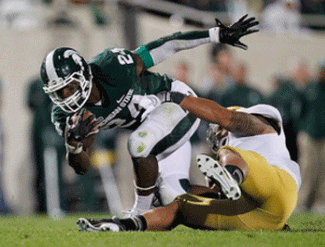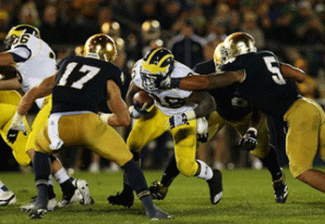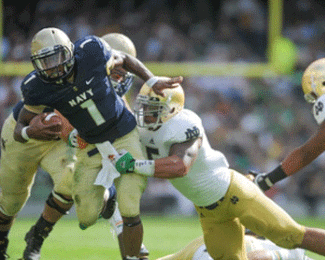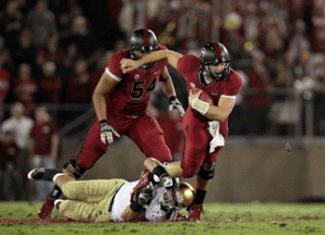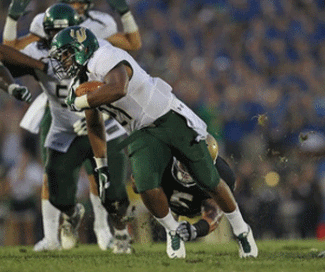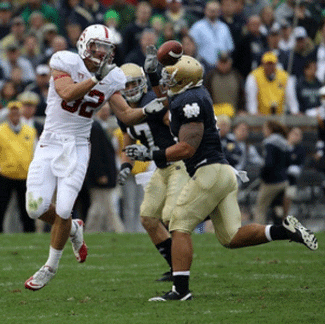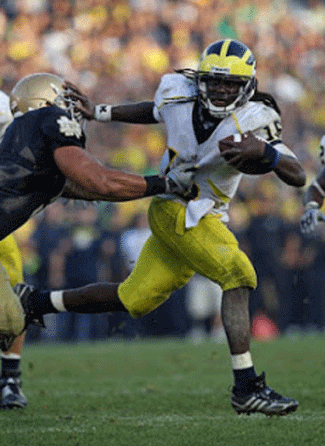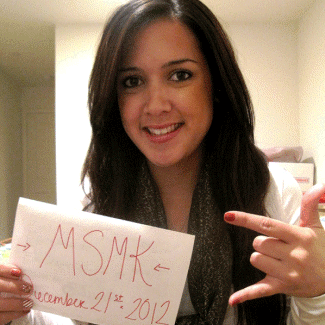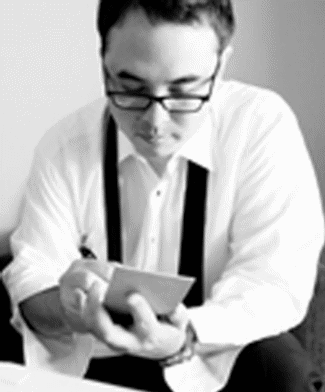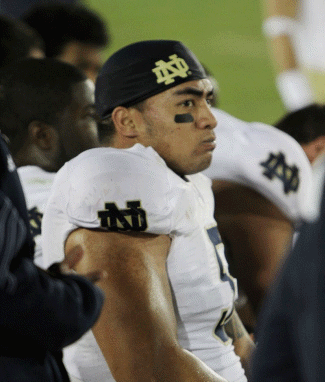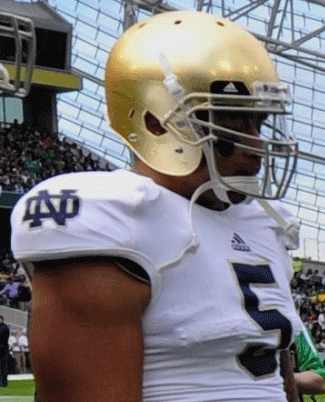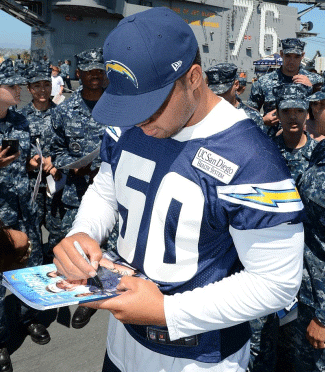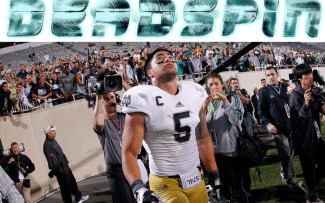by Manny Randhawa
Feb. 26, 2013
NOTICE: THIS WORK MAY BE PROTECTED BY COPYRIGHT
YOU ARE REQUIRED TO READ THE COPYRIGHT NOTICE AT THIS LINK BEFORE YOU READ THE FOLLOWING WORK, THAT IS AVAILABLE SOLELY FOR PRIVATE STUDY, SCHOLARSHIP OR RESEARCH PURSUANT TO 17 U.S.C. SECTION 107 AND 108. IN THE EVENT THAT THE LIBRARY DETERMINES THAT UNLAWFUL COPYING OF THIS WORK HAS OCCURRED, THE LIBRARY HAS THE RIGHT TO BLOCK THE I.P. ADDRESS AT WHICH THE UNLAWFUL COPYING APPEARED TO HAVE OCCURRED. THANK YOU FOR RESPECTING THE RIGHTS OF COPYRIGHT OWNERS.
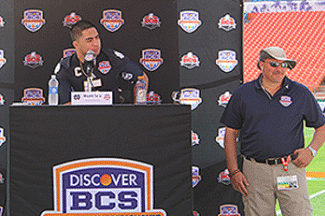
Manti Te’o talks to press prior to the BCS bowl game in Miami earlier this year. (Photo by Matt Velazquez)
Editor’s Note: Certain language in the responses below that was deemed inappropriate for this forum has been omitted. Such omissions are denoted with a bracket [ ]. The context and meaning of the responses, however, have not been altered in any way as a result.
It was “a question of journalistic standards.”
That’s how The New York Times described the rationale of ESPN executives in their decision not to publish the Manti Te’o girlfriend hoax story based on the information they had on January 16th, the same day that Deadspin decided to go ahead with the now famous scoop. “We were close,” ESPN’s Senior Vice President and Director of News Vince Doria told The Times. “We wanted to be very careful.”
While some of the network’s executives reportedly regretted being beaten to the story by Deadspin – which The Boston Globe‘s Jim McBride called “a website that has broken some high-profile stories but not an outlet regarded for journalistic standards” – the investigation and reporting of Deadspin’s story raise the question of whether the Te’o hoax revelation was the result of responsible journalism or a case in which an entity that broke a big story without completing its due diligence got lucky that it was right.
Washington Post contributor Erik Wemple described Deadspin‘s investigation this way: “Deadspin never got Tuiasosopo [the confessed perpetrator of the hoax] on the line to hear his side of the story. Nor did it get Te’o or his father or Notre Dame. It also wrote a media story without consulting all the various media outlets that fell for the hoax.” Beyond reporting on the hoax itself, Deadspin also included quotes from an unnamed source in its original story that strongly implied Te’o’s own involvement in the ruse.
Since the story broke, both Te’o and Tuiasosopo have come forward and said that Te’o had absolutely nothing to do with the hoax.
In light of comments that have been made by Deadspin Editor-In-Chief Tommy Craggs about established news outlets such as The Boston Globe (calling the paper “a craven, slipshod outfit”) and ESPN (calling the network “a terrible company full of craven morons”), does Deadspin have standing to level such criticism given its own standards of journalism?
The National Sports Journalism Center sought answers about Deadspin‘s reporting on the Te’o story from Craggs, who edited and made the decision to publish it last month.
Q: What was the first indication that there was a real story here? Reporter Timothy Burke said that Deadspin received an anonymous email stating that there was “something fishy” about the Te’o girlfriend story. How did things progress from that email to a decision to pursue the story?
A: We got a tip around 4:30 p.m., Jan. 11. That was a Friday, five days before our story ran. The email read in part: “I know you guys get thousands of tips that are ‘out there’ or crazy. This is one that should really be looked into. I was born and raised a Laie Boy on the North Shore of Oahu. While Manti Te’o is a loved native son here in Hawaii he is also a fraud. The story about his girlfriend dying is completely made up. It is a case of the media simply being too sensitive and shocked to actually look into it.”
By that evening, we’d dropped a plumb line into the hole at the center of the dead-girlfriend story. We’d done a ton of googling and some quiet, on-little-cat-feet reporting (we didn’t want to alert anyone, hoaxers and media alike, that we were on the case), and we knew enough to know we had something–we weren’t sure what it was yet.
Q: Ed Sherman wrote the following about a quote toward the end of the Deadspin story on the Te’o girlfriend hoax: “If I’m the editor, I don’t let that quote go through. Who was this friend of Tuiasosopo? Was this person also involved? Friends have a tendency to talk out of school. Maybe this person exaggerated the quote just to be part of the story?” and “So now you’re running an incredibly damning quote from a single source who likely doesn’t know the complete story. 80 percent sure is long way from 100 percent sure in this instance.”
How do you respond to that? What’s the rationale behind adding that friend’s opinion in the piece at all? In light of ESPN’s report that Ronaiah Tuiasosopo admitted to the hoax and that Te’o was not involved in it, does the quote in the Deadspin story accomplish anything other than leading the reader to believe that Te’o was somehow involved?
A: This is a concern troll’s complaint. It’s moronic. That’s a quote from a source who knew both the hoax and hoaxer better than anyone we’d spoken with. It contains its own grain of salt. Eighty percent is not 100 percent: congratulations, Ed Sherman, you can understand the basic English words and number concepts that went into the quote. Yet 80 percent is nevertheless “incredibly damning.”
There are 2,000 words of context preceding that quote, context that was perfectly understood by everyone who read the story except committed Notre Dame truthers and certain willfully dense journalists who were determined to remind people that Deadspin isn’t real journalism. When the story broke, almost none of the people who gleefully jumped on Manti Te’o pulled out that quote to make the case. Only retroactively did people decide this had been the prosecutorial pivot of the piece.
Here’s what we knew at the time we wrote the story:
1. Manti Te’o’s dead girlfriend was a hoax.
2. Manti Te’o had told lies about his dead girlfriend to help create the published stories about his dead girlfriend.
The evidence supported–and, frankly, still supports–a degree of skepticism about the Manti-as-duped-romantic story. We wanted to relay our source’s belief and be transparent about his uncertainty. There is nothing outrageous about that. A newspaper would’ve written it up as “a source strongly believes etc.,” and no one would’ve said [anything]. (Take the fourth graf here, for example: http://www.nytimes.com/2013/01/29/sport ... wanted=all)
Again, I know why that criticism is being leveled. It’s not an epistemological issue, even though it’s being couched smarmily as one. It’s just a way of saying, “Don’t forget–Deadspin is still scurrilous crap.” If it hadn’t been the 80 percent quote, it would’ve been something else. (I’ve seen a handful [of] journalists bitching that we didn’t give Manti or Notre Dame enough time to respond, which is ridiculous given both the observer effect of reporting a story like this and the fact that both Notre Dame and Manti were prepared to go public with the story.)
Q: Deadspin then came out with another post on the same day the ESPN Outside the Lines report on Tuiasosopo’s confession came out, naming the “80 percent sure” source (Vaosa) and continuing to use the quote under a headline that included the phrase: “Was Te’o Involved? Evidence Varies.”
Again, what is the rationale for continuing to use Vaosa when doing so could arguably suggest that Te’o was involved, before all of the relevant information, including Te’o’s own testimony regarding the matter, had come out? (In his interview with ESPN’s Jeremy Schaap, airing after the above-mentioned Deadspin post was published, Te’o denies being involved in the hoax)
A: We weren’t just using Vaosa. We were also using Te’o’s own comments about his girlfriend (and those of his father), and our own judgment that Te’o’s new account wasn’t squaring with everything else we’d learned to that point. (And for the record, we mentioned that quote again to point out that the same person who led Shelley Smith to the source to whom Ronaiah had confessed–and supposedly absolved Manti–was the same person who had expressed doubts to us about Manti’s innocence. That seemed relevant.)
In any case, we saw no reason not to remain skeptical of a guy who had just copped to “tailoring” the story of the dead love of his life to the same media through which he was now asserting his innocence in heavily brokered interviews.
Q: Tom Scocca told The Washington Post: “Craggs kept popping up out of his chair and pacing, asking, ‘Is there any way we could have gotten this wrong?’ Then he would sit down again and then pop up again.” The author of the WP blog post wrote: “Deadspin never got Tuiasosopo on the line to hear his side of the story. Nor did it get Te’o or his father or Notre Dame. It also wrote a media story without consulting all the various media outlets that fell for the hoax. Why would it publish without those critical components? Competition.”
Does competition justify publishing the story without, as the blogger writes, “those critical components”? Couldn’t the story run even after such a press conference took place or “friendly” story was published, once those important components had been added to ensure accuracy?
Based on what Scocca said about your concern over whether you might’ve “gotten this wrong,” it’s clear that you felt there was some risk involved with publishing the story when you did. What is Deadspin’s policy on how certain it has to be before publishing a story? Is it 80 percent, like the quote from the friend cited in the last question? If the policy is that something less than 100% certainty is acceptable in some cases, how is that determined?
What if it turns out that some or all of the information in a story is incorrect? Does Deadspin have a correction policy? There doesn’t appear to be one posted on the site if there is. If one exists, what is it and where is it displayed?
A: [OK, this is Scocca, to address this particular point: This idea that the anecdote about Craggs pacing and fretting represents some sign that we knew we were running with a shaky story–this is utter crap. I knew Wemple was smart enough to understand what I was talking about, but I hadn’t imagined how stupid some of his readers and the right-thinking press people would turn out to be.
I’m going to use really […] small words here. The story was solid. But it said that a lot of other stories had been wrong. Everyone wrote that this girlfriend was real. We knew she wasn’t. This is a weird situat–this is a weird thing. A weird place to be. Telling everyone they’re wrong!
Maybe someday, if the people who complained about this anecdote work hard, they will do the same thing. They will write a story that tells people that something they believe in is really not true. It feels freaky. How could all those people be wrong? If they are not crazy, they will wonder if they somehow, somehow got it wrong, even if they are sure from all the facts that they are right. This is what was going on. Tommy Craggs knew that the facts were right. But like any normal person, he found it strange that the true facts were the opposite of the facts that other people had written. So until someone else said, yes, you are right, and everyone else is wrong, he worried. Luckily our story was so right, it did not take long for someone to say that.]
(Craggs:) We did what we could to get those “critical components,” but we weren’t betting our shirts that Notre Dame or anyone from the Te’o camp would to talk to us. It’s fun to imagine some frictionless plane of journalism where potentially hostile sources return phone calls and grudgingly fill in all the blanks out of some sense of duty to the truth, but that’s now what we were working with. If we’d sat on the story for a day, maybe even hours, I have no doubt we would’ve been scooped by the story’s own principals, to say nothing of ESPN.
You’re misreading a native and natural anxiety over a big story as doubts about its veracity. We were reporting that the whole world had gotten something very wrong. If you don’t feel the least bit nervous after hitting the publish button on a story like that, you’re a better man than I.
Our corrections policy is to correct our mistakes. Is that a good enough answer? I get the sense from these questions that you’re trying to measure the distance between what we do and what Responsible Journalists do. So I’ll help: Is our bar for publishing lower than, say, The New York Times‘s? Of course. Have we published stories that lacked perfect, according-to-Hoyle sourcing? Yes. We’re a tabloid at heart. You ask if we have a policy. There is no policy for this, or for anything, really. The whole point of the company is that we trust our reporters to be smart and judicious without having to adopt the ethical pretense that what they’re doing is anything but a sort of professionalized rudeness. I’ll get killed for this, but: Journalism ethics is nothing more than a measure of the scurrilousness your brand will bear. That’s it. Ethics has nothing to do with the truth of things, only with the proper etiquette for obtaining it, so as to piss off the fewest number of people possible. That works fine for a lot of news outlets; we don’t have to worry about niceties.
Q: USA Today reported on the challenges facing sports journalists (and journalists in general) in this ever-changing digital age, in the wake of the Te’o controversy: “new questions are arising about the media’s obligation to fact-check details even amid tighter deadlines, shrinking newsroom staffs and the ceaseless chatter blaring across social media.”
Social media seems to be a significant source for Deadspin’s content. Has the Te’o situation made you look at Twitter, Facebook, and other social media platforms differently in terms of utilizing them for reporting purposes when this hoax has exposed just how deceptive information disseminated over social media can be?
A: That’s how we’ve always treated Twitter and Facebook. What the story showed me, at least, was the importance of both knowing all the resources at your disposal–Tim Burke found the woman in the “Lennay Kekua” photos via a series of reverse/related image searches–and being clever and tireless about using them.
Q: You said in your interview with Poynter that you “have less sympathy for the folks who crafted those painstaking ‘Love Story’-in-cleats feature stories about Manti and his dead girlfriend. Those were dumb, infantilizing stories to begin with, and they were executed poorly and sloppily, and if there’s any lesson to be drawn from this, it’s that this kind of simpering crap should be eliminated from the sports pages entirely.”
Given the inherent inconsistency between publishing a story with concern over its accuracy after-the-fact, as Scocca talked about with the WP, and criticizing other media outlets for “not getting it right,” how would you respond to the argument that what Deadspin has done with its reporting of a story without consulting all of the involved parties is just as bad as the “painstaking” efforts you mention above?
Also, do you mean that poorly executed and sloppy versions of such human-interest sports stories should not be published, or that human-interest stories of any kind about athletes don’t belong in sports media?
A: I think I’ve answered the first part of your question, about our “concern over .. accuracy after-the fact,” which, again, is based on a misreading that makes my eyes roll into the back of my head and out the other side.
I’ll address the latter question: The Te’o myth was stupid to begin with and premised on the misbegotten and fundamentally patronizing notion that a football player lifted himself nobly to athletic greatness on the coffins of his dead girlfriend and grandmother. Is that a “human interest” story? I dunno. Is there anything human about reducing the complexities of a half-known situation to an old story trope that was tired and worn-out long before the last reel of Knute Rockne, All American?
What’s so human about treating the tragic death of a young woman as a modular piece of the formula, to be used and set aside–on the one hand, she’s dead; on the other hand, he got two interceptions!
Q: The Boston Globe’s Jim McBride described Deadspin as “a website that has broken some high-profile stories but not an outlet regarded for journalistic standards.” In response, you told Poynter: “Whatever. Why should I care what a craven, slipshod outfit like the Boston Globe thinks of my ‘journalistic standards’?”
Apart from being indifferent to what someone at The Globe thinks about Deadspin’s journalistic standards, how do you respond to that statement? How would you characterize your journalistic standards? Some would argue that headlines such as “Lance Armstrong’s Biggest Crime was Being a Huge A–hole,” and posting and responding to reader comments/questions such as “I want to film myself having sex with my wife without her knowing,” characterize poor or nonexistent journalistic standards. How do you respond?
A: I think I’ve answered this. Two things, though: What the hell does using the word “asshole” have to do with journalistic standards? You’re conflating decorum with reporting. And it’s literally half a century since those particular standards of decorum were generally applicable. As for the reader questions–in addition to its various advice columns, sometimes addressing sex questions, the Boston Globe runs a daily “Astrological Forecast” column, complete with lucky numbers for your birthday. Fraudulent, superstitious garbage. Does that mean they have nonexistent journalistic standards? No, the soft sections are the soft sections. Using them to characterize a whole publication betrays a basic ignorance of the industry.
Q: With respect to the reporting on the Te’o situation, Deadspin’ s post “ESPN Reports Ronaiah Tuisosopo [sic] Confessed to Te’o Hoax in December. Was Te’o Involved? Evidence Varies” includes a reader comment at the bottom that reads:
“Look at these f—ing Samoans, with the stripes on their face. They look so sweet, but they lie and now they’re boxed in. I wish they’d take their coconut and go elsewhere. Eh, f— it. Give me three of them plus two Thin Mints.”
This is just one of several comments laced with profanities or racial epithets appearing on Deadspin’s site. Does Deadspin have a policy on the detection and removal of offensive reader comments? If so, what is that policy and where is it displayed?
A: You’re really obsessed with policies, aren’t you? We moderate our comments to the best of our abilities. The commenting system is designed to float the best responses to the top. Bad comments get buried (and occasionally deleted outright).
The comment you cited above does not contain a “racial epithet,” by the way. It’s a joke about Girl Scout cookies. Are there any actual racial epithets you’d like to bring to our attention?

